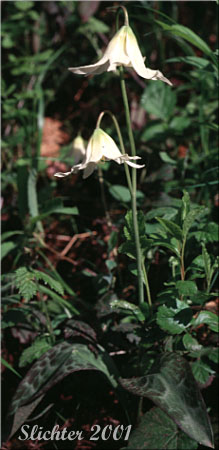 The
photo at right represents the giant fawn lily as found at Camassia Nature Reserve
in West Linn, OR.........4-21-2001.
The
photo at right represents the giant fawn lily as found at Camassia Nature Reserve
in West Linn, OR.........4-21-2001.
Giant fawn lilies are attractive wildflowers with one to several narrowly to broadly oblong-lanceolate leaves up to 20 cm in length. The leaves narrow abruptly to short, wide petioles, and the leaves are strongly mottled. The leafless stems rise 12-30 cm high and are capped with one (usual) to three pendant flowers.
The 6 tepals are narrowly lanceolate and are broadest below the midlength. The flowers are white or slightly pinkish-tinged. They are purplish near the base on the dorsal or outer surface and the inner surface has a broad yellow band. The tepals range from 4-5 cm in length. The filaments are white and narrowly elliptic-lanceolate and broadened above the base to conceal the ovary. The anthers are white or light yellow and range from 5-6 mm long.
Giant fawn lilies make fine wildflowers for the woodland garden. They spread slower than some erythroniums, but are dependable bloomers in early april and are attractive with their mottled leaves and pendant, creamy blooms. Plants should not be dug from the wild as they can be fairly easily obtained from native plant nurseries on the west side of the Cascades.
Giant fawn lilies are found in moist springtime meadows (on gravelly or alluvial soils) and moist woods. This plant typically withers and disappears by mid to late spring.
Giant fawn lilies are common from southern British Columbia south to the west of the Cascade Mts. through the Puget Trough (not on the west slopes to the Olympic Mts.) to Josephine County in the Willamette Valley of Oregon.
In the Columbia River Gorge, it may be found between the elevations of 100'-300' from east of Washougal, WA to the slopes to the east of Cape Horn.
Fawn lilies are beautiful meadow plants for naturalized yards, especially if established in dense drifts. The mottled leaves are attractive early in the season as they emerge, and the flowers generally last a week or more. I have noticed with the cool, wet spring of 2006 that they seem to be somewhat susceptible to herbivory from small garden slugs.